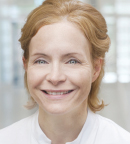
Selma Ugurel, MD
Selma Ugurel, MD, of the Skin Cancer Center Essen at the University of Duisburg-Essen, Germany, discussed the Merkel cell carcinoma presentations at the 2018 ASCO Annual Meeting. “Immunotherapy is of high interest in Merkel cell because of the high immunogenicity of the tumor—viral-induced and ultraviolet radiation–induced—leading to high efficacy from anti–programmed cell death protein 1/anti–programmed cell death ligand 1 (anti–PD-1/PD-L1) immune checkpoint inhibition,” she said. The same cannot be said of ipilimumab [Yervoy], however, as the interim analysis of the phase II ADMEC study was negative, and the study was halted.”
First-Line vs Second-Line Setting
Based on the studies by Drs. Nghiem and Topalian, Dr. Ugurel offered a few observations for anti–PD-1/PD-L1 antibodies in the first-line vs second-line setting. In advanced disease, response rates are much higher in the first-line setting (56% vs 33%), median progression-free survival is much longer (17 months vs 3 months), and 2-year overall survival rates are higher (69% vs 36%). She believes that previous chemotherapy impairs the outcomes of immunotherapy in this cancer, although the underlying molecular mechanism is unclear.
“We can assume, from melanoma, that it may be related to mutations in immune regulatory signaling pathway molecules, exhaustion of T cells, antigen loss, or human leukocyte antigen loss,” she said. “This means that patients need anti–PD-1/PD-L1 in the first line, with chemotherapy postponed to the second line or later.”
Dr. Ugurel further observed that in both the first and second lines, the plateau phase of progression-free survival emerges around 10 months. It is after 12 months that the rate of disease progression slows in both lines of treatment, and durability of response can be claimed.
Finally, she noted similar patterns of resistance for the two settings. Rapid disease progression in the first 3 months is indicative of primary resistance. Early secondary resistance, ie, acquired resistance, emerges around month 10. Occasionally, patients develop late secondary resistance, beyond 12 months. The difference is that the rate of primary resistance is much higher in the second-line setting, although secondary resistance rates are similar.
Future Research
As for neoadjuvant nivolumab, she was encouraged that high response rates were achieved after two doses. “If this leads to a survival advantage vs surgery only, this needs to be investigated in randomized comparative trials,” she said.
Future research should also aim to identify a biomarker of response, especially since PD-L1 levels and viral status are not associated; determine the drugs’ efficacy in immunocompromised patients, who make up a significant portion of this population; establish the optimal treatment of patients who become resistant to immunotherapy; and create a registry of patients treated with immunotherapy. ■
DISCLOSURE: Dr. Ugurel disclosed relationships with Bristol-Myers Squibb, Merck Sharp & Dohme, Novartis, and Roche.

